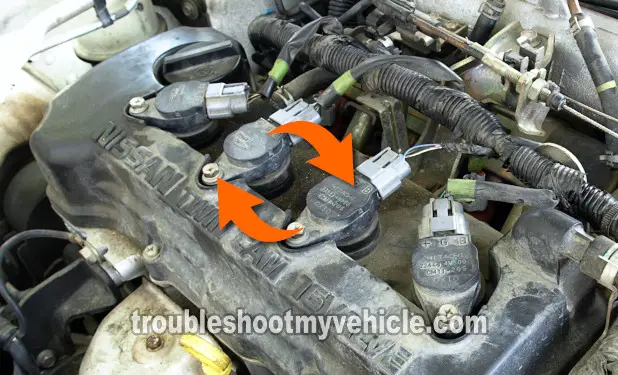TEST 3: Swapping The Ignition Coil

So far your tests have found an ignition coil that is not sparking. To ensure that that particular ignition coil is getting all of its signals, I recommend swapping out that ignition coil for a different one.
I don't mean going out and buying a new one. I mean, just swap that ignition coil with one of the others on your Nissan's engine.
To explain in a little more detail what we're trying to achieve, the idea behind this coil swap is twofold:
- We'll see if the non-sparking ignition coil now fires when connected to a different electrical outlet.
- -AND-
- Check that the other ignition coil (which sparks) sparks in the non-sparking coil's electrical connector.
Why this extra step? Again, you just want to make sure that the non-sparking ignition coil gets all three signals it needs to spark (these 3 signals are: power, Ground, and the trigger signal).
Alright, this is what you'll need to do:
- 1
Disconnect and remove the bad ignition coil that did not spark.
- 2
Remove one of the other ignition coils from its place.
NOTE: You need to make sure that this COP ignition coil sparks. - 3
Connect the good ignition coil to the electrical connector of the bad ignition coil.
- 4
Connect the HEI spark tester to the good ignition coil.
- 5
Ground the HEI spark tester directly on the battery negative (-) terminal with a jump start cable.
- 6
Install the bad COP ignition coil in the location of the good one and bolt it down.
- 7
Once everything is ready, have your helper crank the engine.
- 8
You'll see one of two results:
1.) The good ignition coil will spark.
2.) The good ignition coil will not spark.
Let's take a look at your test results:
CASE 1: The COP ignition coil sparked. This tells you that the non-sparking ignition coil is bad and needs to be replaced.
Here's why: By connecting a good ignition coil to the electrical connector of the bad one and making sure it still sparks, you confirm the following:
- It's getting power (10 to 12 Volts).
- It's getting a trigger signal (known as the IC -Ignition Control- signal).
- It's getting Ground.
CASE 2: The ignition coil DID NOT spark. This tells you that the reason the ignition coil did not spark is because its electrical connector is not providing one of three signals it needs to fire spark.
Your next step is to:
- Check that the ignition coil is getting power (10 to 12 Volts).
- Check that the PCM is providing a trigger signal. This signal is known as the Ignition Control (IC) signal.
- Check if the ignition coil is getting Ground.
Although these specific tests are beyond the scope of this tutorial, you now have an idea of where your diagnostic/troubleshooting needs to go.
TEST 4: How To Do A Cylinder Balance Test
It's quite common that the fuel injection computer (PCM) does not set a specific misfire code even though the car is misfiring. If this is happening in your particular situation, there's an easy way to find out which cylinder is the one that's 'dead' (misfiring).
To find the 'dead' cylinder, you must perform a cylinder balance test. The cylinder balance test simply involves disconnecting one fuel injector at a time while the engine is running.
If the cylinder is 'dead' to begin with, disconnecting its fuel injector will not affect engine speed (engine idle).
If the cylinder is not 'dead', disconnecting its fuel injector will result in a drop in engine idle speed.
NOTE: You can also unplug the ignition coil, although this is not the preferred method as it will load the cylinder with excess fuel.
This is what you'll need to do to perform a cylinder balance test:
- 1
Start the engine and let it idle.
NOTE: This test is done with the engine running. So be careful, stay alert, and think safety all of the time. - 2
Disconnect the #1 cylinder fuel injector from its electrical connector.
- 3
You should see/hear a drop in engine speed while the injector stays disconnected.
NOTE: A drop in engine speed confirms the cylinder is OK (not dead or misfiring). - 4
Reconnect the fuel injector to its electrical connector.
- 5
Repeat steps 2 through 4 on the remaining three fuel injectors.
Let's take a look at what your cylinder balance test results mean:
CASE 1: Unplugging a fuel injector DID NOT affect engine speed. This test result tells you that this particular cylinder is 'dead'
You can now start from TEST 2: Check The Ignition Coil For Spark and check to see if the COP ignition coil is bad or not.
CASE 2: Any fuel injector that became disconnected from its electrical connection affected the engine speed. This tells you that all ignition coils and fuel injectors are working properly.
If you're still experiencing a rough idle condition or an engine cylinder misfire, one of the following issues could be the cause:
- One or more engine cylinders have very low compression, or individual cylinder compression varies by more than 15%.
- A vacuum leak from leaking intake manifold gaskets or vacuum hoses.
- Dirty fuel injectors.
Although testing the above conditions is beyond the scope of this article, now you know what direction to take your troubleshooting efforts.
More 1.8L Nissan Sentra Tutorials
You can find more 1.8L Nissan Sentra tutorials in this index:
Here's a small sample of the tutorials you'll find in the index:
- How To Test The Starter Motor (2000-2002 1.8L Nissan Sentra).
- How To Test For A Blown Head Gasket (2000-2006 1.8L Nissan Sentra).
- How To Test Engine Compression (2000-2006 1.8L Nissan Sentra).
- How To Test The 2000-2002 Nissan Sentra 1.8L MAF Sensor (at: easyautodiagnostics.com).

If this info saved the day, buy me a beer!


